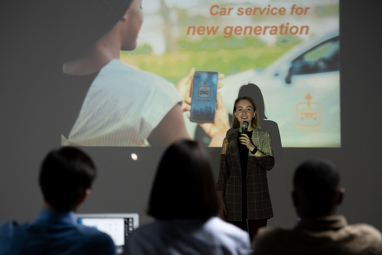
Video displays play a significant role in the student experience on college and university campuses. They support applications that fall into three categories:
Specialized academic spaces
- Examples include film studies spaces, CAVEs, and specialized learning spaces where extended and virtual reality is used to support advanced visualization and learning;
Mainstream academic spaces
- Examples include auditoria and new classrooms;
Non-academic spaces
- Examples include alumni and student centers, athletic centers, conference centers, donor walls, museums and lobbies.
Choosing the right display technology is a delicate balance between technology and architecture. In mainstream academic spaces, the front wall is the most coveted real estate, and your decisions on its allocation and use are crucial.
 Projection systems with motorized screens have been popular due to their cost-effectiveness and ability to roll up, revealing writing surfaces. However, they can be limiting as students often can’t view both computer graphics and the professor’s notes. Contrast is often compromised due to the need to keep the room lit for hybrid or other videoconferencing or recording applications.
Projection systems with motorized screens have been popular due to their cost-effectiveness and ability to roll up, revealing writing surfaces. However, they can be limiting as students often can’t view both computer graphics and the professor’s notes. Contrast is often compromised due to the need to keep the room lit for hybrid or other videoconferencing or recording applications.
Reimagining classroom and auditoria architecture can unlock a world of possibilities. With stadium seating, the front wall could house writing surfaces at standing height, complemented by dynamic video displays above. Direct-view LED technology will deliver vibrant, high-contrast, high-resolution images that thrive in well-lit environments. If you are limited on height, the other advantage of LED is you no longer need to worry about shadows at the front of the room. Moreover, these displays require minimal maintenance, and when needed, they can be easily accessed at the front of the room instead of having to access equipment high in the ceiling or other hard-to-reach places.

In specialized academic environments with extended reality, direct-view LED offers a solution that is easier to set up and maintain than projection. Setting up and maintaining multiple blended projectors to create a seamless image is complex and requires an ongoing effort. LED also enables immersive experiences that work equally in bright or dark environments. It works well with video cameras for a video backdrop or an XR stage. The spectacular color depth, contrast, resolution, and available tight pixel pitches make this an ideal technology for film study spaces and screening rooms.
Rounding out the campus experience, there are many applications for non-academic spaces. Large screen displays are common in high-profile areas to attract attention or create an atmosphere. Direct-view LEDs can be used indoors and outdoors; they offer protective coatings for durability, are flexible in where they can be installed, and can be used for multitouch interactive applications.
A few other considerations that make direct-view LED a better choice over other technologies in campus environments are:
- The flexibility to put images in hard-to-reach or cover areas like on the face of a soffit or curved walls;
- Flexibility in aspect ratio. For example, native support for 21:9 for the latest UC applications like Microsoft Teams with Front Row;
- Lower-cost all-in-one solutions with multitouch for fixed or flexible installation with mobile stands;
- Their total cost of ownership, cost competitiveness for high-resolution and high-brightness displays and projection systems, and extended runtime are advantageous over other technologies.
In summary, tremendous advancements have been made in direct-view LED, which lowers the price of entry, provides a suite of options to overcome environmental, architectural, and support challenges, and offers a competitive total cost of ownership.
About CDA
CDA is a design and consulting firm with over 30 years of experience delivering technology solutions for modern work, learning environments, and broadcast and production facilities. For questions, consultation, or simply to talk tech, you can contact us via our website: https://www.cdaconsultants.com/



